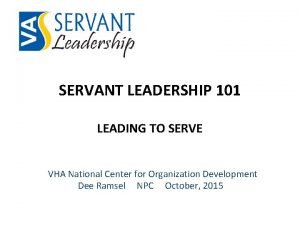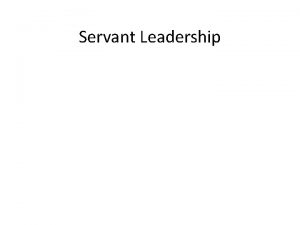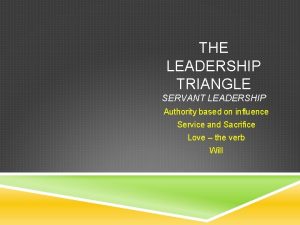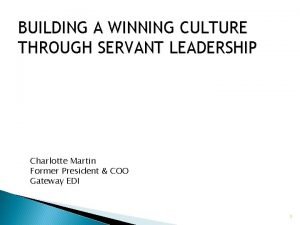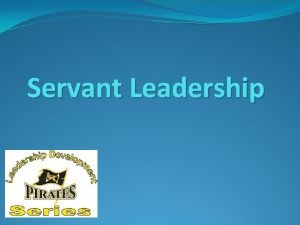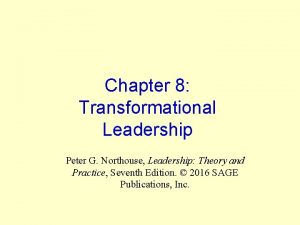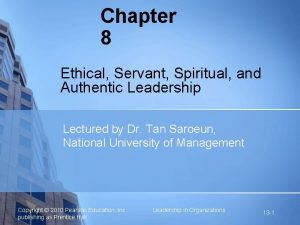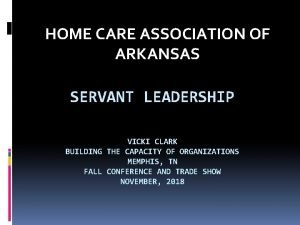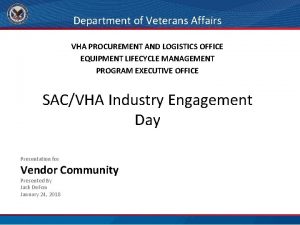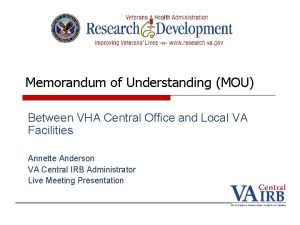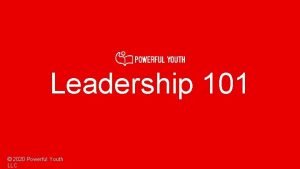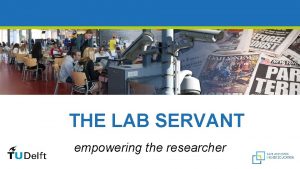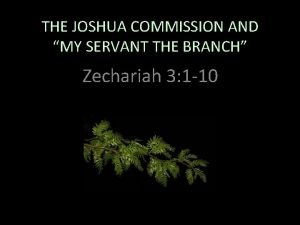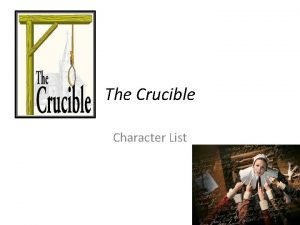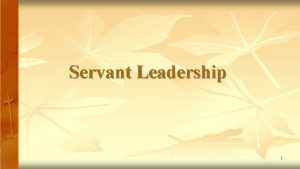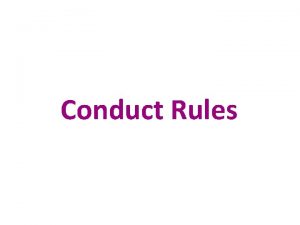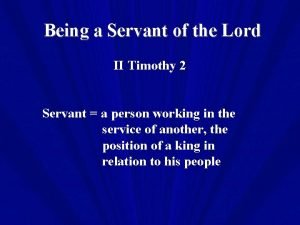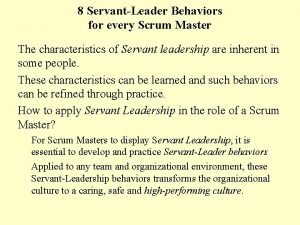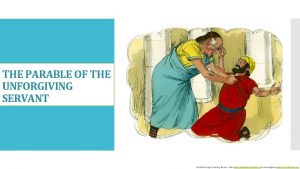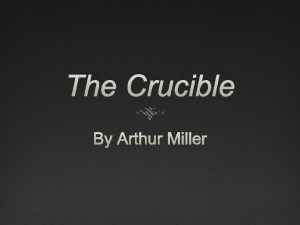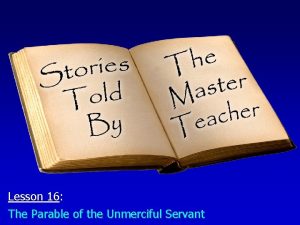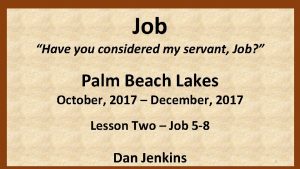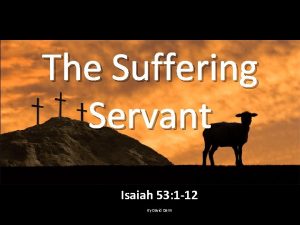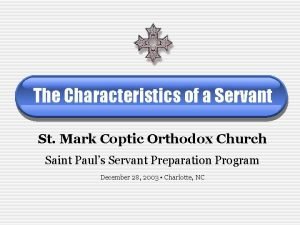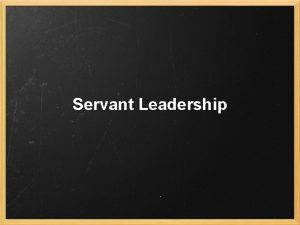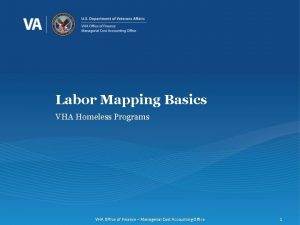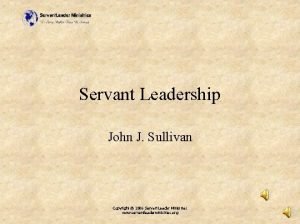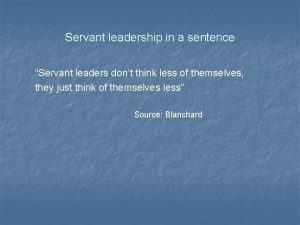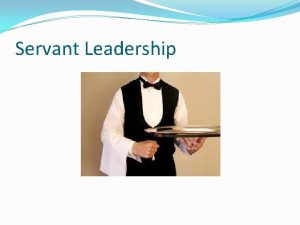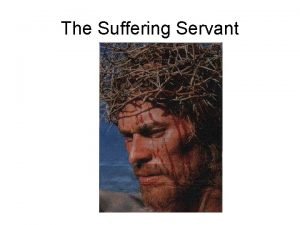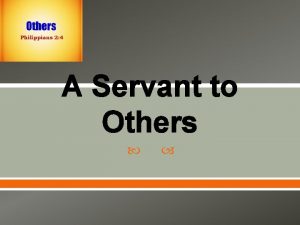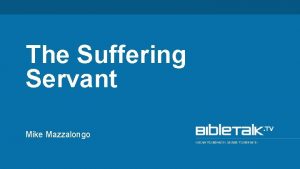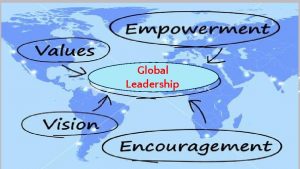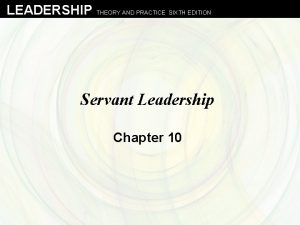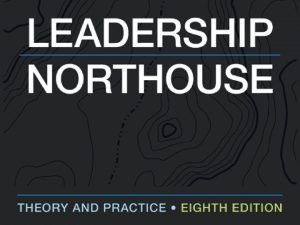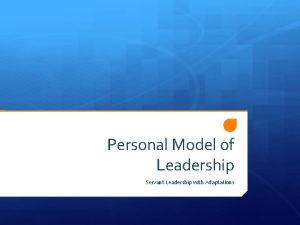SERVANT LEADERSHIP 101 LEADING TO SERVE VHA National

















































- Slides: 49

SERVANT LEADERSHIP 101 LEADING TO SERVE VHA National Center for Organization Development Dee Ramsel NPC October, 2015

Why Servant Leadership In VA?

Affordable Care Act Workforce barriers Heightened Consumer Demands Troops returning after a decade of war Scanning the Environment (Foresight) Quality, access and timeliness demands Congressional/ public expectations Resource challenges

Servant Leadership and VA: Natural Partners Impact on health care and benefit challenges – Supports maximizing human investment – optimizing budget care dollars; creating value – improving quality and outcomes – ensuring a positive experience for Veterans/families – developing leaders with courage and vision VA and Servant Leadership: Serving those who served 4

Transformational Workplace: All Things Connected Veteran/ Family- Centered Customer Service Safe, Timely, Quality Outcomes Serving the Veteran. Centric Serving the Employee CREW (civility) Systems Redesign Engagement Effective Teams Serving the Organization Leadership Ethics Learning Organization Servant Leadership Transformation is Culture Change 5

What is Organizational Culture? Culture 6 Taken-for-granted values, assumptions and expectations that characterize organizations and their members.

Summary - What is Culture? Values of Organization Time Personality of an Organization Blueprint of an Organization How Things Are Really Done Process Water-Cooler Conversations What Doesn’t Change Around You-When Everything Else Does Culture Happens by Intention or Default 7

Leadership Hows / Whats of Culture How Decisions are Made How Problems are Resolved How Conflict is Handled How Information is Shared (or Not) 8 How Bad News is Received What Behavior is Modeled How nonperformance is handled What Behavior is Rewarded

Leaders Create the Culture… Culture Eats S trate gy Strategy for Lunch…. Culture Hard Skills Culture; Organizational Health Focus Culture spills over into: • Workplace perceptions • Organizational performance • Customer experience Failure to change the culture dooms other organizational change. 9

A Healthy Organization… Balances Immediate Nurtures Success in Tasks With Building Connects all Employees Complex & Chaotic Incubator for Personally to VA Mission Systems That Organizations Transformation Strengthen Over VA Time Employees Choose To Work 10 Veterans Choose to Receive Service A Healthy Organization is foundation, not fluff

“Ninety percent of what we call ‘management’ consists of making it difficult for people to get things done. ” Peter Drucker 11

Toolkit Exercise Think of an Historical Figure You Consider a Servant Leader. Why? Now think of someone who has been a servant leader in your life. Why? What characteristics do you think of in a servant leader? 12


Servant Leadership… a philosophy and practice Servant Leadership is not a project or a program, but an organizationally healthy way of doing business. It cultivates capabilities, commitment and a personal connection to the mission of the organization. 14 Servant Leadership

t n a v r e S ip h s r de a e L Theory X Theory Y Path / Goal 15 MBWA MBO Situational Transformational Life Cycle Trait Theory Transactional Theory Z Good to Great It’s not about a single style of leading….

Test of a Servant Leader Do those served grow as persons? Do they become healthier, wiser, freer, more autonomous, more likely themselves to become servants? Leaders Servant First, Leader Second 16 We’re all leaders, all the time.

Research Shows… Servant Leadership positively influences: • Collaboration & effectiveness (Parris & Peachey) • Service orientation (Wong & Davey) • Helping / Organizational citizenship behaviors (Erhart) • Perception of fairness (Walumbwa) • Influence of / satisfaction with supervisor (Laub) • Innovation (Jaramillo) • Employee satisfaction & engagement (Cerit) • Communication and trust (Liden) • Supports organizational transformation (Patterson) 17

Fortune 500 Companies ROI (%) 30 24. 5 25 20 17. 5 15 10. 8 10 5 0 No change in leadership practice Good to Great leadership Servant Leadership

What is unique to SL? Focus on serving followers for their own good, not just the good of the organization Self-reflection, humility, the art of withdrawal Concern with the success of all stakeholders Encouraging growth and development to reach highest potential The moral component (moral authority)

Leaders Power Model Positional Authority Command & Control Who Messed Up? The end justifies the means People Are Tools Demand loyalty 20 Service Model Moral Authority Guide, Teach & Equip Glitch Hunts, Not Witch Hunts Message, mentor & model Build Communities of Support Inspire followership

Power and Control The more you control others, the more likely it is that they will rebel. Posner and Kouszes Lots of things are outside our control. We get to decide who we are going to be and how we are going to live. Servant Leadership is not about giving up one’s self-interest, not about self-sacrifice or self-denial. It’s about self-fulfillment. 21 Keith Realistically, someone will be in power. Servant Leaders can accumulate and exercise power, can become angry and do battle, but they do it on behalf of others. Keith Control is an illusion. - Belton

“When you’re a hammer, everything looks like a nail. ” Servant Leaders aren’t hammers: they’re the whole toolbox. 22

23

Implementing Servant Leadership in VA: Challenges to Change • Bureaucratic/ Political Environment • Size • Realities of culture change • Misperceptions 24

Facing the Misperceptions

• Misperception: You can’t practice Servant Leadership in a government agency.

Misperception: Servant Leadership isn’t strong leadership. I don’t want to be seen as a pushover.

Servant Leadership: Not for the Fainthearted! • It is not soft • Requires: –Strength of self-mastery –Strength of action –Strength of relationships • In healthy organizations, power is the capacity generated by relationships. • SL’s operate from courage, persistence, integrity, strong internal compass. 28

Misperception: The term “servant” is a turnoff/ offends me. Difference between “service” and “servitude”

Misperception: I can’t embrace SL if my supervisor doesn’t. Don’t wait for the memo! - Don’t underestimate your power to change the workplace.

We’re all Leaders All the Time… Everybody can be great because anybody can serve. You don’t have to have a college degree to serve. You don’t have to make your subject and verb agree to serve. You only need a heart full of grace. A soul generated by love. - Rev. Dr. Martin Luther King, Jr. 31

SERVANT LEADERSHIP IN VA

Orchestrating Servant Leaderspeak from the top 33 Servant Leadership in VA VA ACHE Greenleaf Conf. Singapore CDC Board Membership 50+ Presentations Organizational Health Newsletter

Growing Servant Leadership in VA 360 Servant Leadership in VA Leadership Programs 34 SL 360 Self. Assessment 180 SL 180 Self- Assessment Ultimate goal: a Culture of Servant Leadership

7 Pillars of Servant Leadership 7 Pillars 1. Person of Character 4. Compassionate Collaborator 2. Puts People First 3. Skilled Communicator 7. Leads With Moral Authority 5. Has Foresight 6. Systems Thinker 35 James Sipe & Don Frick (2009)

Servant Leadership 360 Assessment — Introduced Sept. 2013 — MBI added Jan. 2014 o — 180 added in January 2015 — A Report — Average scores by type of 360 180 SL 360 Self. Assessment SL 180 Self. Assessment respondent — Explanation of scores and the model — General Information about SL — Tools, tips and templates — List of additional resources — Development Guide Contact: Jaimee Robinson, NCOD VETERANS HEALTH ADMINISTRATION 28

Serving Others…Sharing Power Personal, Team, Organization Success Build on strength Blaze the Trail Raise the Bar Upend the Pyramid Run To Great Purpose - Ken Jennings, 3 Rivers Consulting 37 SERVANT LEADERSHIP

Practices that Strengthen Servant Leaders: the Art of Withdrawal and Reflection

Withdraw to Renew, Refresh • The ability to replenish, reorient and recharge oneself, if only for a moment • To build in regular opportunities for reflection; gain perspective • To sort out the more important from the less important, the important from the urgent 39

bed r o s b a t s e b is n rmatio o f in x le p m o c y ssed e s s a r e t t Technicall e b e r a tions a u it s d e g r a h c y ge r e m e o t Emotionall ly e k li t e mos r a t h ig s e r o f d n Intuition a ppen a h n io t a v o n in g and in k in h ht t g e li iv o t t a s e e r C m o c e r futu e h t r o f n io is v l u A meaningf ade m e r a s t n e m g d vident d, ethical ju e e Sound, m o c e b s n io decis d e s u c o f , s, u s o e g than Coura r e t a e r g g in h t e som Connecting with self occurs 40 Business Case for Reflection

Reflection • What prevents me from regular reflection? • What can I do to ensure it? 41

Servant Leadership is not a Race: It’s a Journey

Sowing the Seeds…. Sustaining the Culture 43

Translating into Practice: Building and Supporting the Culture • No playbook: only guiding principles • Every employee must translate principles into practice. • What is meaningful to me? • Why is this important? • What will I do differently? • How can I be invested in a Culture of Service? • How do I demonstrate a personal commitment to 44 VA’s mission?

Our Role as Servant Leaders • • • Be ‘intentional’ about crafting the culture Withstand the pressure to ‘live’ in the weeds Teach and model Build bridges, not silos; community, not competition. Create more serving leaders. We’re all leaders, all the time. Help those around us develop their Internal Dialog 45

Internal Dialog of a Servant Leader • Why do I serve? Service is not a byproduct of leadership: it is the whole point. • Whom do I serve? How do I define our customers? Our community? • How do I serve? ‘Serve’ is a verb! • How do others observe me serving? I’m not a servant leader unless others see me as one. 46

Toolkit Exercise The 2, 000 year-old Chinese text, Commitment “Tao Te Ching, ” teaches that the least desirable leader is one whom followers despise and defy; next What two things will I commit to doing comes the one whom they fear; to grow as a Servant Leader? better is the one whom they love and praise. But the highest leader 1. ___________________ is one of whose existence they are barely aware. The greatest success of this leader is that when the 2. ___________________ task is accomplished, people can say, “We achieved it ourselves!” 47

The 2, 000 year-old Chinese text, “Tao Te Ching, ” teaches that the least desirable leader is one whom followers despise and defy; next comes the one whom they fear; better is the one whom they love and praise. But the highest leader is one of whose existence they are barely aware. The greatest success of this leader is that when the task is accomplished, people can say, “We achieved it ourselves!” 48

For more information, please contact VHA National Center for Organization Development (NCOD) Telephone: Email: Website: 49 (513) 247 -4680 VHANCOD@va. gov http: //vaww. va. gov/NCOD http: //www. va. gov/NCOD
 Difference between public servant and civil servant
Difference between public servant and civil servant Vha leadership
Vha leadership Objectives of roving frame
Objectives of roving frame Servant leadership definition
Servant leadership definition Servant leadership vs followership venn diagram
Servant leadership vs followership venn diagram 7 pillars of leadership
7 pillars of leadership The servant leadership triangle
The servant leadership triangle Servant theories
Servant theories Servant leadership
Servant leadership What we will cover today
What we will cover today Servant leadership theory and practice
Servant leadership theory and practice Northouse leadership
Northouse leadership អភិសមាចា
អភិសមាចា Servant leadership webinar
Servant leadership webinar Jan ardui
Jan ardui Army servant leadership vs followership venn diagram
Army servant leadership vs followership venn diagram Servant leadership theory
Servant leadership theory 12 principles of servant leadership
12 principles of servant leadership Boost mobile sales portal
Boost mobile sales portal Va form 10-250
Va form 10-250 Vha procurement and logistics office
Vha procurement and logistics office Vha central office
Vha central office Titolante
Titolante Ihi leadership alliance
Ihi leadership alliance Leadership 101 presentation
Leadership 101 presentation Leadership 101
Leadership 101 Transactional leadership and transformational leadership
Transactional leadership and transformational leadership What is adaptive leadership style
What is adaptive leadership style Capable but cautious performer
Capable but cautious performer Short summary of merchant of venice
Short summary of merchant of venice Labservant tudelft
Labservant tudelft The joshua commission
The joshua commission Ezekiel cheever the crucible character traits
Ezekiel cheever the crucible character traits Leader definition oxford
Leader definition oxford Romeo and juliet prologue
Romeo and juliet prologue Balthasar romeo and juliet
Balthasar romeo and juliet Beadisciple com lay servant ministries
Beadisciple com lay servant ministries Is allah not sufficient for his servant
Is allah not sufficient for his servant Odisha conduct rules 1959
Odisha conduct rules 1959 Faithful servant of god
Faithful servant of god Scrum master servant leader behavior
Scrum master servant leader behavior Ana servant
Ana servant Servant letwatch.us
Servant letwatch.us Who is the proctors new servant
Who is the proctors new servant Who wants the prince to execute romeo
Who wants the prince to execute romeo What are the models of the church
What are the models of the church Parable of the suffering servant
Parable of the suffering servant Have you considered my servant job
Have you considered my servant job Isaiah chapter 53
Isaiah chapter 53 Characteristics of a servant of god
Characteristics of a servant of god

